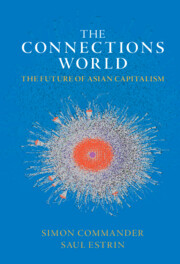Book contents
- The Connections World
- The Connections World
- Copyright page
- Dedication
- Contents
- Figures
- Colour Plates
- Tables
- Acknowledgements
- Abbreviations
- 1 The Strengths and Fallibilities of Asian Capitalism
- 2 To the Foothills of Everest
- 3 The Power of Networks of Connections
- 4 Networks, Connections and Business Organisation
- 5 What Scope for Innovation?
- 6 Employment in the Connections World
- 7 Whither Asia?
- References
- Index
1 - The Strengths and Fallibilities of Asian Capitalism
Published online by Cambridge University Press: 11 October 2022
- The Connections World
- The Connections World
- Copyright page
- Dedication
- Contents
- Figures
- Colour Plates
- Tables
- Acknowledgements
- Abbreviations
- 1 The Strengths and Fallibilities of Asian Capitalism
- 2 To the Foothills of Everest
- 3 The Power of Networks of Connections
- 4 Networks, Connections and Business Organisation
- 5 What Scope for Innovation?
- 6 Employment in the Connections World
- 7 Whither Asia?
- References
- Index
Summary
This chapter provides historical background on Asia, amid talks of an Asian twenty-first century. We show that Asia’s resurgence has been based on models that differ substantively from those of capitalist development in Europe and North America, not least through the heavy reliance on the state. Further, they have had many common features, not least being centred on the pervasive use of connections – familial, commercial and political. We term these networks as the connections world. Whilst this world has been supportive to growth and development, it contains major fallibilities. These include cronyism and its consequences – high inequality and corruption. In addition, the connections world breeds market power which impairs efficiency and innovation. The resulting structure of the economy also holds back the creation of good jobs. Much of the connections world is also associated with autocracy or heavily managed democracies and this introduces risks of instability. As such, the broad model that has helped Asia grow so strongly is less likely to be so supportive in future. Rethinking the connections world will be required – not an easy task given strongly embedded and resilient foundations.
- Type
- Chapter
- Information
- The Connections WorldThe Future of Asian Capitalism, pp. 1 - 27Publisher: Cambridge University PressPrint publication year: 2022

